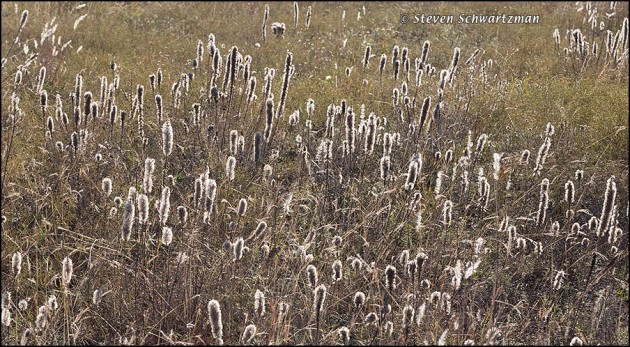Blazing-star turned fluffy
Do you remember Liatris mucronata, known as gayfeather and blazing-star? (You’re welcome to look back at a flowering group to refresh your memory.) Here’s what a colony of it looks like after the plants have gone to seed and turned fluffy. As in other recent photographs, lighting from behind helps outline the stalks; in this case it was the light of the late-afternoon sun on November 19th on the west side of US 183 in Leander, a fast-growing suburb north of Austin.
© 2014 Steven Schwartzman











Liatris is one of my favorite natives. As your image points, it is as lovely in full bloom as in its final stages.
lensandpensbysally
January 2, 2014 at 7:45 AM
Then I’m happy to have served up these luminous Liatris for you, Sally.
Steve Schwartzman
January 2, 2014 at 8:10 AM
Step back a bit. Imagine a stone fence behind you, the horizon ahead and acres and acres that look just like this. Welcome to the Flint Hills in autumn.
The backlit grasses are as pretty as the Liatris. I’m looking forward to seeing a field in full bloom some day.
shoreacres
January 2, 2014 at 8:47 AM
And from your description I’m hoping I’ll get to see the Flint Hills in autumn someday. Finding a field of Liatris in full bloom should be easier because there’s no need to leave Texas.
Steve Schwartzman
January 2, 2014 at 9:15 AM
I love these backlit scenes. They look like torches held up against the sky. The idea of following through the stages of of withering flowers is crucial for learning about them. I have a Calopogonium caeruleum that supposedly yields seed pods, but I’m debating whether to go ahead and just post the image of the flower. I usually like to feature the whole cycle in one post; but fruiting times, I’ve noticed, may take longer than expected. I’m expecting seed pods from the afore mentioned, but none yet. We in P.R. now have another flowering season right now.
Maria
January 2, 2014 at 9:51 AM
For the first time I’m also noticing that I’m unable to ID some wildflowers. I’m desperately looking for an authority publication on wildflowers of the Caribbean, with images. But I haven’t been able to find one. I now have about 5 I’m unable to ID.
Maria
January 2, 2014 at 9:55 AM
Welcome to the club. There are many native species here that I can’t identify, even with some good field guides.
Steve Schwartzman
January 2, 2014 at 12:21 PM
Do you still post them? I have this issue with posting unknown species. There was a site for identifying flowers but there weren’t enough moderators and wildflowers are not as popular as ornamentals.
Tropical Flowering Zone/Maria
January 2, 2014 at 3:58 PM
In general I don’t post an unknown plant unless I can at least say what the genus is. Sometimes I’ve shown unidentified insects or spiders.
Steve Schwartzman
January 2, 2014 at 4:08 PM
It’s a coincidence that you mention torches because the upper part of a dry Liatris stalk has often reminded me of a candle.
I show different stages of a plant when I can, but they’re usually spread out over the year as the plant develops. That assumes I manage to get good pictures of each stage, something that’s often hard to do because there are so many native species and some of them cross my path only rarely. As a result, my photographs might be called opportunistic.
With your tropical climate, you’re fortunate to have flowers throughout the year.
Steve Schwartzman
January 2, 2014 at 12:19 PM
Yes, I’m glad to be here for that reason. I still haven’t gone to the mountains. All I’ve shown are urbanised flora.
Tropical Flowering Zone/Maria
January 2, 2014 at 4:03 PM
Then here’s to the mountains that await you.
Steve Schwartzman
January 2, 2014 at 4:08 PM
fabulous
sedge808
January 2, 2014 at 7:27 PM
That’s how I saw this field, and I took lots of pictures of it.
Steve Schwartzman
January 2, 2014 at 9:31 PM